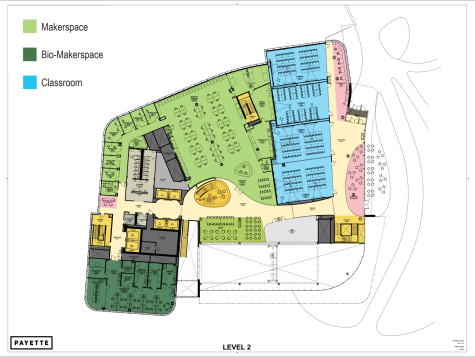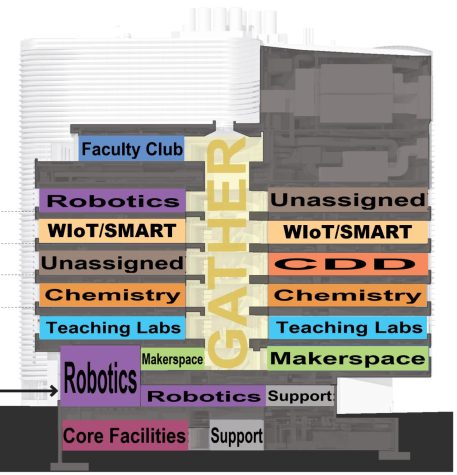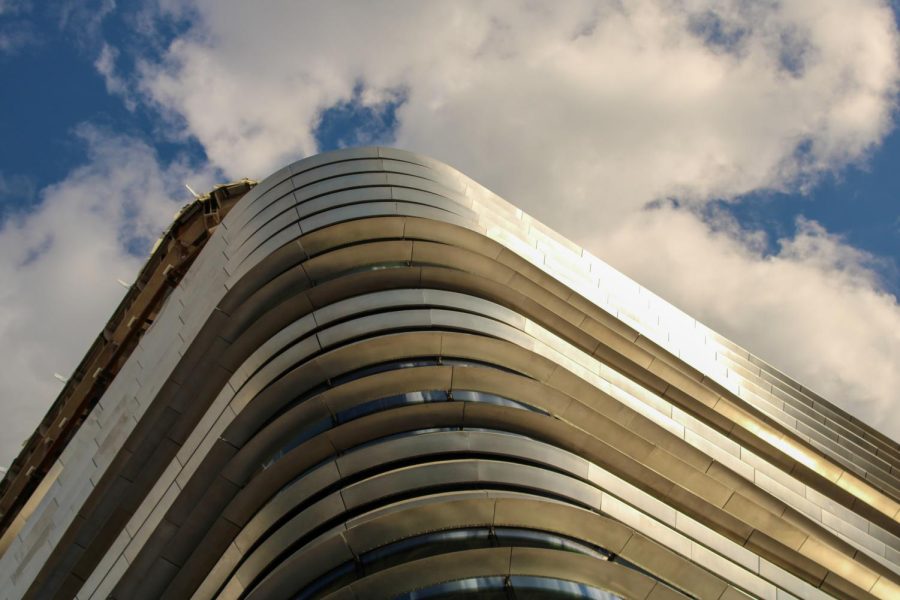Northeastern’s newest research building moves toward completion
September 8, 2022
While students have watched the construction site looming over Ruggles train station slowly come to resemble a building over the past two years, the project’s final year of construction will bring less outwardly noticable changes as it sprints toward completion.
The large construction site is none other than the final building in the complex containing the Interdisciplinary Science and Engineering Complex, or ISEC, and the iconic rust-colored bridge across the Ruggles train tracks. The new building is called EXP, which, unlike ISEC, isn’t an acronym.
This complex has been in the works since 2012, when Payette architects Kevin Sullivan and Bob Schaeffner won a competition to design the space. When they first came up with the swoosh motif for the bridge crossing the train tracks, they said, they realized the entire complex needed to be about flow and movement.
“We almost thought of it like the whole site had two hard shells on the perimeter with a soft connective tissue in the middle, almost like an oyster or something,” Sullivan said. “But when we started thinking about the urban design, we didn’t want the block to be too monolithic. So EXP is similar in some ways, but different — it doesn’t have the same skin.”
Though it is apparent that EXP and ISEC go together, the internal workings of the newer building may be more of a mystery to some students.
“It’s a much more industrial building, much more work focused, research focused, student focused,” said Jacqueline Valencia, a senior project manager, referring to the building as a “workhorse.”
Construction, overseen by Suffolk Construction, started on the $300 million dollar building in spring 2020, at the start of the pandemic. While supply chain delays and high inflation rates have made headlines throughout this project, Paul McAndrew, another senior project manager, said the construction team did not feel the effects too much.
“We did a lot of our buyout in advance of inflation and supply chain issues really hitting the industry hard,” Valencia said. “So that’s not to say that we haven’t had some of those issues, but just not nearly as much as others in the industry.”
Now, the project is entering its last year of scheduled construction, with the 350,000-square-foot building expected to open fall 2023. This fall, the project managers said they will make the building weather tight so progress can be made on interior details.
“We’ve got the shell almost substantially complete and it’s basically finished, so drywall, … flooring, paint, bringing in furniture, putting in audio visual systems — anything that kind of needs to be protected we wait until that weather tight mark so that it’s a secure space and a safe space to put equipment and things,” Valencia said.
The bridge was intended to create a link that extends the campus over the train tracks. Schaeffner said the idea was that nobody in the new complex should feel isolated from the science programs on the central campus — the bridge is intended to avoid ISEC and EXP becoming an “ivory tower.”
ISEC’s opening in 2017 was the first stage of the project, followed by the opening of the rust-colored bridge in 2019.
The swoosh shape of the bridge is intended to flow very naturally into the larger complex and create a sort of “pebbles in a stream” effect with the buildings, Schaeffner said.
“President Aoun drove us hard to get to something that nobody’s done before. I have to hand it to him because as a partnership, it’s been incredible,” Schaeffner said. “When he’s not satisfied, he can’t even always explain what it is. But when there’s something bugging him you know it’s for real, and he’s helped us elevate.”
So what will the interior of EXP actually look like?
While the building, located at 815 Columbus Ave., has certain similarities to ISEC (it is, after all, another STEM hub on campus), the design is “totally different,” Sullivan said. When you walk into ISEC from street level, on the right side there are several floors of laboratories stretching above the first floor, but on the left there are smaller “beans,” or clusters of offices.
“It’s a series of clusters of labs that are about a [half] the length of ISEC that pinwheel around a central space and it’s very small — it’s like a communicating stair that goes up through all the floors. And then the offices are sort of embedded within the laboratories on the perimeter,” Sullivan said.
Schaeffner described the pinwheeling lab clusters as “little neighborhoods.”
“This is so smaller scale research groups could actually have their own little community on each floor, so there could be different specialties and different things going on,” Sullivan said. “This was to give Northeastern a different type of community, they already have sort of a big open lab model, which is in ISEC, and EXP is actually more intimate.”
EXP’s footprint is about one-and-a-half times the size of ISEC, and it allows for public spaces that radiate out toward the exterior like spokes on a wheel, Schaeffner said.
“Whereas ISEC is inward looking toward the atrium as a space, this pushes those social clubs to the perimeter. It’s a reversal in a sense,” Schaeffner said. “It’s definitely a more intimate and less singular feeling probably than ISEC. But yet it harmonizes.”
At the center of the pinwheel is a “collaborative hub” with conference rooms and other amenities, the architects said.

“That public space in the center is quite a bit smaller than the space in ISEC. But the intention is about the intensity of that community of people,” Sullivan said. “They are all glass walls looking toward the center. And you’re almost getting to look into three or four different lab communities simultaneously.”
Students returning to campus this fall will likely notice that the walkway between ISEC and EXP is closed, as it has been since May. It is closed until the end of the school year, Valencia said, to facilitate the construction of an underground utility connection between the buildings.
Once completed, people will only have to be outside for about 50 feet to get between the first floor of EXP and the revolving door in ISEC, the project managers said.
“One thing about the [plaza] connection, we are doing a utility connection under it. So there’s a chilled water connection between EXP and ISEC so there’ll be a district for chilled water,” Valendica said. “[It’s] just an efficiency of resources there and I think it’s a huge benefit to the campus in general.”
One thing EXP shares with ISEC is a statement staircase, though EXP’s is almost the inverse of ISEC’s.
“ISEC has that elemental stair that sits in the atrium and [in EXP it] kind of cuts through. It still makes that same connection floor to floor that ISEC has, but it’s just a completely different vantage point,” Valencia said. “We’ve got a couple of pictures of it during construction, and it’s already looking cool without any of the finishes.”
This statement staircase was both McAndrew and Valencia’s favorite element of the building and goes from the second floor all the way to the research level at the top of the interior space.
“The structural way that it’s connected to the building too is a little bit different than ISEC — where ISEC is connected at floor levels, but it kind of sits as a foundation to it, this stair is almost hung from the structure. You’ll be able to see the rods that hang it from each floor level,” McAndrew said.
Beyond the central staircase, other features include a two-story robotics high bay with garage doors leading out to the street — most noticeable from Columbus Avenue.
Another exciting feature of EXP is a roof deck on the eighth floor that will be designed to be open to the campus community during fall, summer and spring, the architects and project managers said.
“I think the roof garden is going to be a remarkably iconic piece of history and experience,” Sullivan said. “If it’s allowed to be used, if your Adirondack chairs make it up there, I think that’ll be very interesting.”

The building is overall a bit taller than ISEC, with EXP having eight floors plus a penthouse as compared to ISEC’s six floors. Five floors in EXP will be dedicated to research in anything from “chemistry, biology, physics, engineering, dry labs, antibiotics,” the architects said.
“[On] the ground floors of this building there are going to be so many more students taking classes. [With] the makerspace, the classrooms, the chemistry teaching labs, all that — there’s going to be a lot more students,” Sullivan said.
The upper floors, much like ISEC, will have seating areas for students and staff to get work done.
The university also has plans to have EXP LEED certified, a designation of the building’s environmental impact. McAndrew said the goal is to reach LEED Platinum, one designation higher than ISEC. To achieve the LEED Platinum certification, the project must earn a certain number of points by adhering to prerequisites and credits by addressing things like carbon, energy and water.
“We’re [getting points] through electric vehicle charging stations in [a] neighboring garage and also another project that is going to be loaning Northeastern some points for LEED is a photovoltaic project, so a solar project,” McAndrew said.
The vision for the both buildings in the complex was initially “flamboyant, organically shaped” buildings, but when making the vision a reality, Schaeffner and Sullivan used climate response as a way to make the buildings real. For example, ISEC has vertical external screening intended to minimize heat gain from the sun and help the building run more efficiently.
EXP also has a rain collection system, low consumption toilets and furniture from recycled materials. Valencia said that throughout the building process, the university made choices to minimize the impact on the environment. In the overall plans for the complex, the architects included features like HVAC and air circulation techniques to more efficiently use pure air.
Though the project is still a year out from completion, the Northeastern community is close to having a brand new 350,000 square foot state-of-the-art research center.







